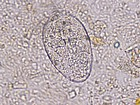Difference between revisions of "Paramphistomum"
Jump to navigation
Jump to search
| Line 1: | Line 1: | ||
| − | + | ||
| + | |||
[[Image:Paramphistomum cervi.jpg|right|150px|thumb|''Paramphistomum cervi'' - Joaquim Castellà Veterinary Parasitology Universitat Autònoma de Barcelona]] | [[Image:Paramphistomum cervi.jpg|right|150px|thumb|''Paramphistomum cervi'' - Joaquim Castellà Veterinary Parasitology Universitat Autònoma de Barcelona]] | ||
| − | + | ||
| − | + | ''Paramphistomum spp'' are of the family ''Notocotylidae''. ''Paramphistomomes'' are rare in the UK, but can cause severe losses in ruminants in the wet tropics | |
| − | + | ||
| − | + | The adult fluke is plump and cylindrical (unusual for a [[Trematodes|trematode]]). It attaches to the wall of the rumen without causing serious damage. The eggs are like those of ''Fasciola'', but are colourless, and have long filaments present at the poles. | |
| + | |||
*The intermediate hosts are water snails | *The intermediate hosts are water snails | ||
**These shed cercariae that form metacercariae on vegetation | **These shed cercariae that form metacercariae on vegetation | ||
Revision as of 13:23, 30 July 2010
Paramphistomum spp are of the family Notocotylidae. Paramphistomomes are rare in the UK, but can cause severe losses in ruminants in the wet tropics
The adult fluke is plump and cylindrical (unusual for a trematode). It attaches to the wall of the rumen without causing serious damage. The eggs are like those of Fasciola, but are colourless, and have long filaments present at the poles.
- The intermediate hosts are water snails
- These shed cercariae that form metacercariae on vegetation
- Disease occurs if metacercariae are eaten in large numbers
- Enteritis and diarrhoea result when immature flukes migrate along the small intestine (where the metacercariae excyst) towards the rumen
